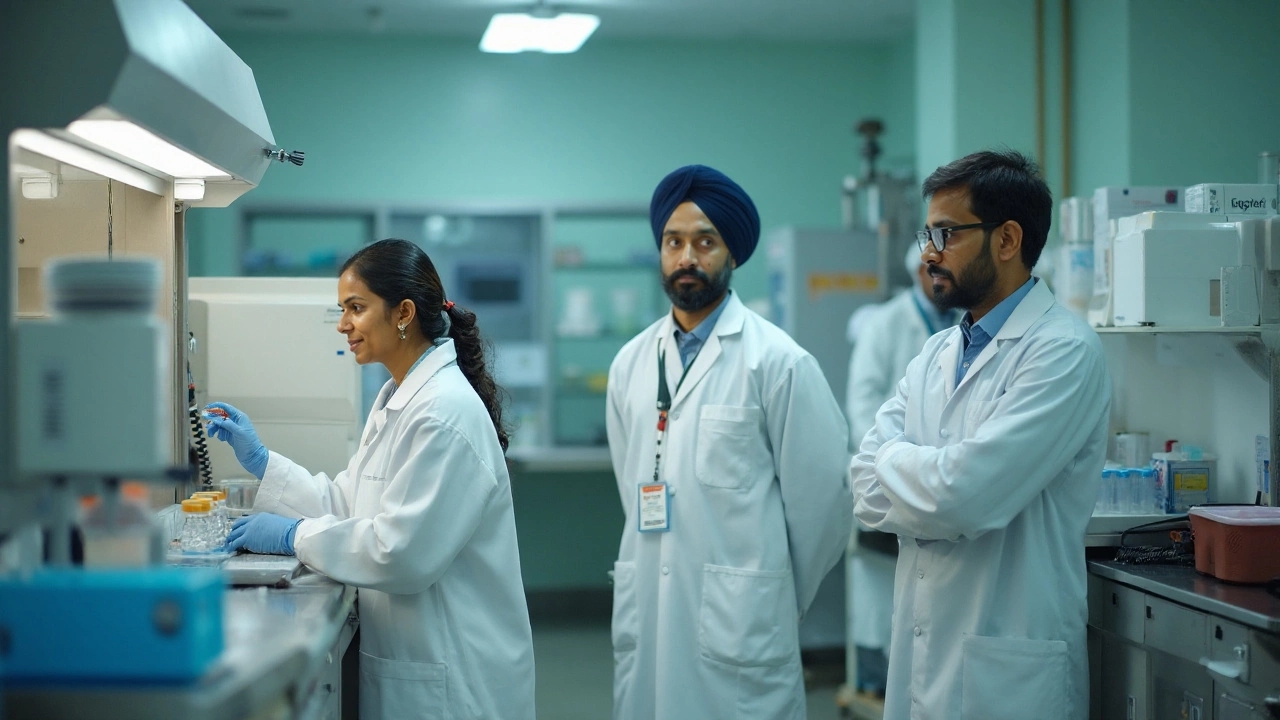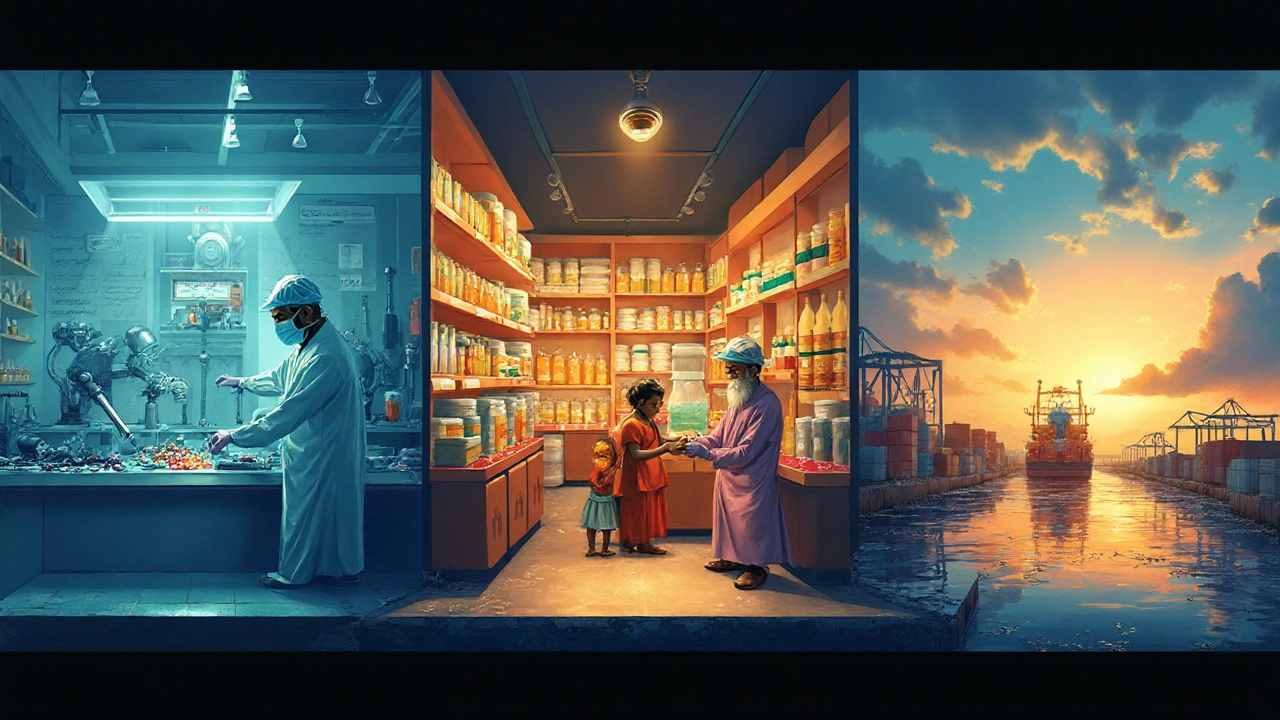Walk into any pharmacy, pretty much anywhere, and there’s a decent chance the pill you pick up started its life in India. That raises a fair question: why there? Short answer-India combines cost advantage, huge manufacturing capacity, a deep pool of chemists and engineers, and a playbook built around generics. It’s not perfect-quality scandals and API dependence are real-but the center of gravity for affordable medicines sits there today.
- India supplies about 20% of global generic drugs by volume and is a leading vaccine producer by doses.
- Cost, talent, scale, and clusters make manufacturing cheaper and faster without cutting corners when plants are well run.
- Patent rules and a strong generics ecosystem let Indian firms move quickly once exclusivities end.
- Quality varies by firm; the top players meet US/EU standards and hold hundreds of inspections and approvals.
- Risks: API dependence on China, logistics shocks, price caps at home-buyers hedge with dual sourcing and deeper audits.
The Short Answer: Why India Makes So Many Medicines
Think of India as the world’s generics engine. The big drivers work together.
- Scale and clusters: Cities like Hyderabad, Ahmedabad, Mumbai-Pune, Baddi, and Visakhapatnam host dense pharma clusters-manufacturers, API makers, packagers, testing labs, and logistics, all in one place. That cuts lead times and costs.
- Skilled labor at scale: India graduates tens of thousands of pharmacists, chemical engineers, and chemists every year. Documentation is in English, which simplifies filings for the US FDA and EU regulators.
- Regulatory know-how: Indian firms have run the generic playbook for decades-master files, bioequivalence studies, ANDAs, and inspections. India has one of the highest counts of US FDA-approved plants outside the US (well over 600 sites).
- Cost advantage: Labor, utilities, and overheads are lower; procurement teams also benefit from a competitive supplier base. With the rupee historically favorable for exports, pricing holds up even with thin margins.
- Policy support: 100% FDI is permitted under the automatic route for new greenfield pharma, and India’s production-linked incentive (PLI) schemes encourage API and complex product manufacturing.
And it’s not just tablets. India is a giant in vaccines by volume. Firms like Serum Institute supply hundreds of millions of doses yearly to global programs. For the US market alone, industry and regulator data commonly note that roughly four out of ten generic prescriptions are supplied by Indian manufacturers.
“About 40 percent of generic drugs used in the United States come from India.” - U.S. Food and Drug Administration, Congressional testimony
When you add it up, Indian pharmaceutical manufacturing is optimized for high-volume, cost-sensitive products where reliability, compliance, and speed to market decide the winner.
How India Got Here: A Fast Timeline You Can Trace
It didn’t happen overnight. Here’s the short path from a small domestic producer to the world’s generics hub.
- 1970s: Patent policy rewires incentives. India’s Patents Act (1970) moved to process patents for drugs (at the time), which encouraged reverse engineering and process innovation for generics. Local companies learned to make complex molecules efficiently.
- 1990s: Liberalization and export mindset. Economic reforms opened markets; pharma firms started filing for US FDA and EU approvals. English documentation and a strong science base helped.
- 2005: TRIPS compliance, but with guardrails. India amended its patent law to recognize product patents, with notable checks like Section 3(d), which raises the bar on patentability of incremental changes. Generics could still compete after exclusivity expired.
- 2010s: Scale and sophistication. Indian companies expanded APIs, finished dosage forms (FDF), injectables, and sterile plants. The number of US FDA and EMA-approved facilities surged. Biocon, Dr. Reddy’s, Sun, Cipla, Lupin, Aurobindo, Zydus, and others became household names in procurement.
- 2020-2022: COVID spotlight. India’s vaccine output and generics supplied global programs. But the pandemic exposed API dependence on China; freight spikes and lockdowns hurt supply chains worldwide.
- 2023-2025: Quality reset and upstream push. India rolled out revised Schedule M Good Manufacturing Practices with tighter expectations (phased through 2025-2026). PLI schemes backed domestic production of key starting materials (KSMs), APIs, and complex generics and biosimilars.
Those milestones built a system that’s uniquely good at making off-patent medicines at scale, with rising capability in injectables, inhalers, transdermals, and biologics/biosimilars.

The Cost and Capacity Math: What Keeps Prices Low
If you buy medicines for a hospital or pharmacy chain, price isn’t just the sticker. It’s labor, utilities, capex, compliance, freight, and failure rates. India’s advantage shows up across the stack.
- Labor: Skilled chemists and operators cost less than in the US/EU while working inside mature quality systems at top plants.
- Capex and overhead: Land, buildings, utilities, and services are cheaper. Clusters mean shared vendors for tooling, validation, and testing.
- Procurement scale: Thousands of firms compete. Buyers can source from multiple US FDA and EU-approved plants, which puts pressure on price and delivery times.
- Documentation and filings: Long experience with ANDAs, DMFs, CEPs, and global pharmacopoeias reduces cycle time and error rates.
- Currency: Exporters gain when the rupee is weaker against the dollar or euro, supporting lower dollar-denominated prices.
Here’s a quick landscape snapshot to make it concrete.
| Factor | India | China | US/EU |
|---|---|---|---|
| Labor cost (skilled shop-floor) | Low-moderate, large pool | Low-moderate, large pool | High |
| US FDA-approved sites | Very high (600+) | High | Very high |
| Primary strength | Generics, FDF, vaccines, some biosimilars | APIs/KSMs, intermediates, increasing FDF | Innovation, complex/sterile, high-compliance FDF |
| Regulatory documentation in English | Yes (native) | Yes (translated) | Yes |
| Export dependence | High | High | Moderate |
| API self-reliance | Improving, still dependent for many molecules | Strong | Moderate |
Note the interplay with APIs. India traditionally imported 65-70% of certain bulk APIs and key starting materials from China. That’s shifting. Government PLI schemes and private investment are pushing more upstream chemistry back home, but it’s a multi-year rebuild.
Also remember pricing rules in India. The National Pharmaceutical Pricing Authority (NPPA) caps prices for essential drugs via the Drug Price Control Order. That keeps medicines affordable domestically but can squeeze margins; exporters offset with scale and higher-value markets.
Examples you can picture:
- US hospital buyers source injectable antibiotics from Indian plants with a track record of clean FDA inspections, often through large group purchasing organizations (GPOs).
- UNICEF and Gavi procure vaccines at scale from Indian suppliers because they can deliver hundreds of millions of doses consistently.
- Retail generics like atorvastatin or metformin often come from Indian lines that run 24/7 with automated compression, coating, and packaging, plus serialization for traceability.
Quality, Regulation, and Risk: What Buyers Should Know
Quality in India isn’t one story. It’s a spectrum-from world-class facilities shipping to the US, EU, and Japan, to smaller outfits that struggle. If you’re a buyer or regulator, you look at firms, not flags.
How quality is managed and measured:
- Inspections and approvals: Top Indian firms maintain dozens of US FDA, EMA, and WHO PQ approvals. Many have long audit histories with big pharma and global NGOs.
- GMP upgrades: In 2023, India tightened GMP rules (revised Schedule M), with deadlines phased into 2025-2026 to raise standards across the board.
- Data integrity culture: Documentation in English, electronic batch records, validated systems, and frequent mock audits are standard at the best plants.
- Learning from crises: Safety incidents with syrups and contaminated products (flagged by WHO and national agencies) prompted stricter testing, solvent controls, and supplier vetting. Reputable exporters now over-test for impurities like DEG/EG and nitrosamines.
What about patents and innovation?
- Section 3(d): India’s patent law resists “evergreening” of drugs with small changes that don’t improve efficacy, which opened space for generics after real exclusivity ends.
- Compulsory licensing: Rare but possible (famously granted in 2012 for a cancer drug). The effect is more symbolic; day-to-day, most competition comes when patents expire or where biosimilar pathways open.
- Innovation shift: While the core remains generics, India is moving into complex generics (inhalers, long-acting injectables, peptides) and biosimilars (insulins, monoclonal antibodies). You’ll see more filings and launches through 2025.
If you buy or partner with Indian manufacturers, here’s a tight checklist that actually helps:
- Regulatory profile: Check US FDA/EMA inspection history, WHO PQ status, and any import alerts. Ask for the last three major audit reports and CAPAs.
- API provenance: Map KSM → intermediates → API → FDF. Dual source where possible. Prefer firms with partial or full backward integration.
- Quality systems: Look for electronic batch records, validated cleaning, nitrosamine risk assessments, and container-closure integrity testing for sterile products.
- Utilities and EHS: Ask about water systems (WFI specs), HVAC, power backup, and effluent treatment (zero liquid discharge where required).
- Serialization and traceability: Confirm DSCSA/Track & Trace readiness for US/EU. Test data exchange before first shipment.
- Capacity buffers: Verify line utilization and changeover times. Ensure surge plans exist for 20-30% demand spikes.
- Business continuity: Get a shipping playbook for port closures, Red Sea disruptions, or sudden freight spikes. Define reorder points and safety stock.
Pro tips that save you time and pain:
- Don’t pick by price alone. Filter by inspection history first, then negotiate.
- Pilot lots tell the truth. Run small batches under commercial conditions before committing large volumes.
- Watch the PLI winners list and tender performance with multilateral agencies-that’s where reliable capacity shows up first.

Quick Answers and What’s Next Through 2025
Short, straight answers to the questions people actually ask.
Are Indian drugs safe? The best of them are as safe as any in the world-those plants pass US/EU inspections and supply major hospitals. Safety issues happen in every region, and India has had painful ones, especially with contaminated syrups. That’s why due diligence matters. Quality is a plant-by-plant call, not a country-level verdict.
Why are Indian generics so cheap? Efficiency and scale, plus lower labor and overhead, a competitive supplier base, and an export-focused model. Many molecules have multiple approved suppliers, which keeps prices honest.
Does India just copy drugs? No. The bread-and-butter is off-patent drugs, which is legal once exclusivity ends. On top of that, there’s real innovation in process chemistry and a growing push into complex generics and biosimilars.
How dependent is India on China for APIs? Still significant for certain antibiotics, vitamins, and fermentation products, though dependence has been easing with new domestic API projects under PLI schemes. It’s a 2-5 year journey to rebuild full capacity in some categories.
Will manufacturing shift away from India? Buyers are diversifying to hedge risk-more suppliers in the US/EU, Southeast Asia, and Latin America. But India’s depth in talent, approvals, and cost isn’t easy to replicate. Expect India to stay central while supply chains get more multi-polar.
What changes by late 2025? Three that matter:
- More complex generics and biosimilars: Inhalers, depot injections, ophthalmics, and insulin biosimilars will see added capacity and filings.
- Stronger GMP baselines: Revised Schedule M deadlines pull lagging plants up. Expect fewer weak links and tougher enforcement.
- Partial API reshoring: New Indian API lines come online, reducing single-country risk for selected molecules.
If you’re making decisions right now, here’s a compact playbook by role.
- Procurement for hospitals/retail: Dual-source critical molecules. Lock options with one India-based and one non-India supplier where possible. Set safety stocks at 1.2-1.5x average lead time demand.
- Distributor/wholesaler: Track DSCSA interoperability and serialization data quality. Score suppliers monthly on fill rate, deviations, CAPA closure, and complaint response time.
- Health system pharmacy: Watch shortage signals (recalls, plant closures). Pre-negotiate emergency allocations. Validate substitutes at P&T committee level ahead of need.
- Startup/brand owner using CMOs: Shortlist CMOs by dosage form specialization. Visit in person. Start with a tech transfer of a low-risk SKU to learn the team before moving a flagship product.
Sources you can trust when you want to go deeper: US FDA inspection databases and testimony, WHO prequalification reports, Indian Ministry of Chemicals and Fertilizers releases on PLI schemes, and IQVIA market data on generics volume shares. These aren’t rumor mills; they shape real procurement and regulatory calls.
If you only remember one thing, make it this: India makes so many pharmaceuticals because it built the muscle for high-volume, compliant, and cost-effective production, then kept lifting heavier-first with generics, now with complex products. The world asked for affordable medicine at scale. India learned how to deliver it.

